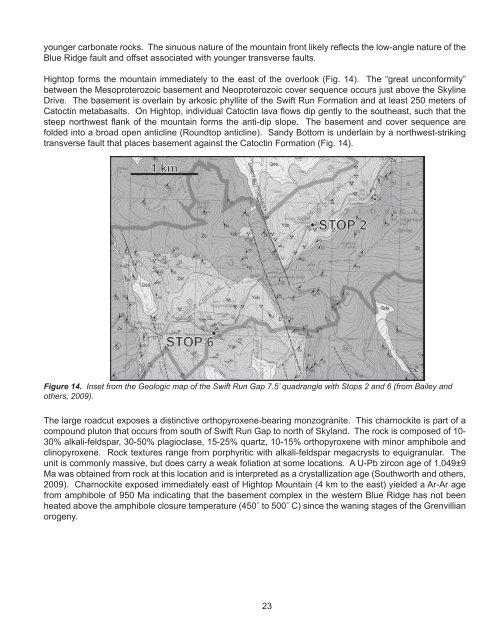Geology of the Shenandoah National Park Region - Csmres Jmu ...
Geology of the Shenandoah National Park Region - Csmres Jmu ...
Geology of the Shenandoah National Park Region - Csmres Jmu ...
Create successful ePaper yourself
Turn your PDF publications into a flip-book with our unique Google optimized e-Paper software.
younger carbonate rocks. The sinuous nature <strong>of</strong> <strong>the</strong> mountain front likely reflects <strong>the</strong> low-angle nature <strong>of</strong> <strong>the</strong><br />
Blue Ridge fault and <strong>of</strong>fset associated with younger transverse faults.<br />
Hightop forms <strong>the</strong> mountain immediately to <strong>the</strong> east <strong>of</strong> <strong>the</strong> overlook (Fig. 14). The “great unconformity”<br />
between <strong>the</strong> Mesoproterozoic basement and Neoproterozoic cover sequence occurs just above <strong>the</strong> Skyline<br />
Drive. The basement is overlain by arkosic phyllite <strong>of</strong> <strong>the</strong> Swift Run Formation and at least 250 meters <strong>of</strong><br />
Catoctin metabasalts. On Hightop, individual Catoctin lava flows dip gently to <strong>the</strong> sou<strong>the</strong>ast, such that <strong>the</strong><br />
steep northwest flank <strong>of</strong> <strong>the</strong> mountain forms <strong>the</strong> anti-dip slope. The basement and cover sequence are<br />
folded into a broad open anticline (Roundtop anticline). Sandy Bottom is underlain by a northwest-striking<br />
transverse fault that places basement against <strong>the</strong> Catoctin Formation (Fig. 14).<br />
Figure 14. Inset from <strong>the</strong> Geologic map <strong>of</strong> <strong>the</strong> Swift Run Gap 7.5’ quadrangle with Stops 2 and 6 (from Bailey and<br />
o<strong>the</strong>rs, 2009).<br />
The large roadcut exposes a distinctive orthopyroxene-bearing monzogranite. This charnockite is part <strong>of</strong> a<br />
compound pluton that occurs from south <strong>of</strong> Swift Run Gap to north <strong>of</strong> Skyland. The rock is composed <strong>of</strong> 10-<br />
30% alkali-feldspar, 30-50% plagioclase, 15-25% quartz, 10-15% orthopyroxene with minor amphibole and<br />
clinopyroxene. Rock textures range from porphyritic with alkali-feldspar megacrysts to equigranular. The<br />
unit is commonly massive, but does carry a weak foliation at some locations. A U-Pb zircon age <strong>of</strong> 1,049±9<br />
Ma was obtained from rock at this location and is interpreted as a crystallization age (Southworth and o<strong>the</strong>rs,<br />
2009). Charnockite exposed immediately east <strong>of</strong> Hightop Mountain (4 km to <strong>the</strong> east) yielded a Ar-Ar age<br />
from amphibole <strong>of</strong> 950 Ma indicating that <strong>the</strong> basement complex in <strong>the</strong> western Blue Ridge has not been<br />
heated above <strong>the</strong> amphibole closure temperature (450˚ to 500˚ C) since <strong>the</strong> waning stages <strong>of</strong> <strong>the</strong> Grenvillian<br />
orogeny.<br />
23


